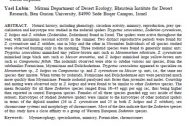Content
Natural history, including phenology, circadian activity, mimicry, reproduction, prey specialization and karyotype was studied in the zodariid spiders Trygettus sexoculatus, Zodarion cyrenaicum, Z. lutipes and Z. nitidum (Zodariidae, Zodariinae) found in Israel. The spiders were active throughout the year, with maximum seasonal activity in the summer. Two distinct reproductive periods were found for Z. cyrenaicum and Z. nitidum, one in May and the other in November. Individuals of all species studied were observed hunting only in the morning. Three zodariid species were found to generally mimic ants: Trygettus sexoculatus mimicked tiny yellow-brown ants such as Monomorium niloticum, Z. cyrenaicum mimicked large black ants such as Messor arenarius, and Z. lutipes mimicked large yellow-brown ants such as Camponotus fellah. The zodariids observed were able to subdue various ant species, from the subfamilies Formicinae, Myrmicinae and Dolichoderinae. Trygettus sexoculatus appeared to specialize on Monomorium sp., Z. lutipes on Camponotus sp. and Z. cyrenaicum on Messor sp. ants, i.e., the same ant species they imitate. When bitten by zodariids, Formicinae and Dolichoderinae ants were paralyzed much more quickly than Myrmicinae. Female zodariid paralyzed ants faster than juveniles and males. Courtship and mating were observed only in Z. lutipes and were found to be similar to other Zodarion species. The mean fecundity for all three Zodarion species ranged from 38–45 eggs per egg sac, thus being higher than reported in central European species. Females of all three species guarded egg sacs inside of their retreats. Karyotypes of studied Zodarion spiders were similar to the karyotypes of other zodariid spiders in terms of the diploid number (26 in Z. cyrenaicum and 25 in both Z. lutipes and Z. nitidum), sex chromosome systems and morphology of chromosomes. Most of the data indicate that the Zodarion species of this study have a close affinity to a group of Western European Zodarion species.



